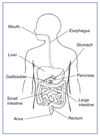Healthy Living Flashcards
Label Digestive System:


What carries glucose fom the intestine to other parts of the body?
Blood
Which organ does drinking too much alcohol effect?
Liver
Which organ does not eating enough fibre effect?
Intestine
Which organ does smoking cigarettes effect?
Lungs
Why do athletes take glucose tablets before a race?
To provide energy
Why do we need to chew our food and mix it with saliva?
The enzymes in our mouth from the saliva break down the large molecules into smaller molecules whih are easier to digeste.
Which organ is harmed if you eat too much fat?
The heart
What does carbon monoxide effect?
It causes red blood cells to carry less oxygen
What does tar effect?
It causes lung cancer
What does nicotine effect?
It causes addiction to smoking
What does ‘immune’ mean?
When the body learns how to deal with a pathogen by creating antibodies
When a person is vaccinated, what do white bood cells produce?
Antibodies
What is present in a vaccine that cause white blood cells to produce antibodies?
What type of micro-organism can infect a cut?
Bacteria

